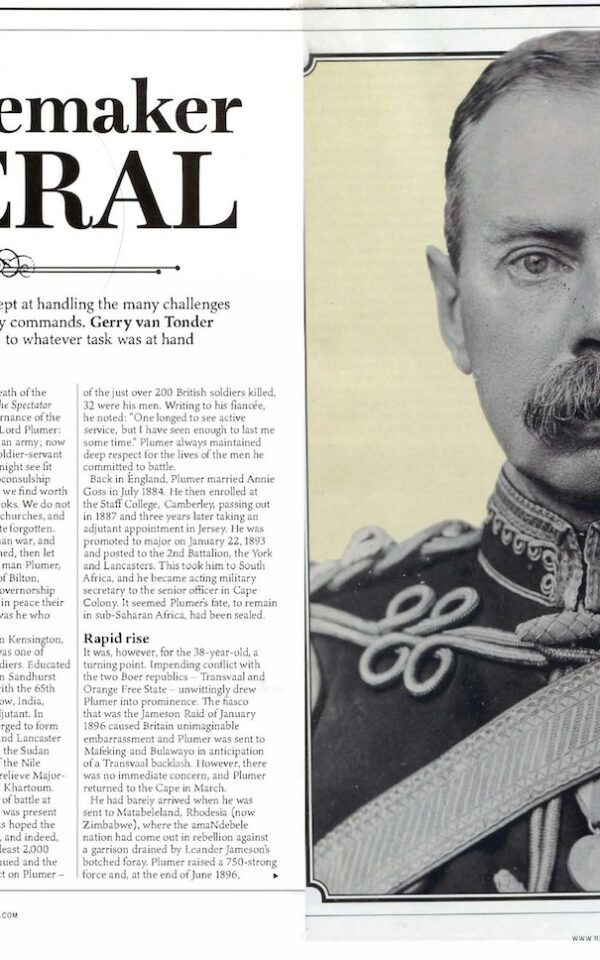By August 1900, ten months after the outbreak of hostilities between British forces and those of the Transvaal and Orange Free State Boer republics in South Africa, Her Majesty’s troops were starting to gain the ascendency across the subcontinent in what became known as the Second Boer War.
By the end of May 1900, and after the military disaster at Spioen Kop, Lord Frederick Roberts had embarked on his great flank march to take Bloemfontein, capital of the Orange Free State. Ladysmith, Kimberley and Mafeking were relieved, and Pretoria and Johannesburg captured.
However, in the north-west of the region there were no British troops. One of only a small handful of British officers in the area, the aging Lieutenant General Sir Frederick Carrington was placed on the staff of the South Africa Field Force and given command of the Rhodesian Field Force.
Roberts now divided the Western Transvaal operational theatre into districts, with the sole objective of mopping up pockets of Boer resistance. The Marico District, including the towns of Mafeking, Zeerust, Lichtenburg and Rustenburg, was assigned to Colonel Baden- Powell, his force comprising 1,100 Rhodesian Volunteers and British South Africa Police (BSAP).
With pockets of die-hard ‘bitter einder’ commandos scattered throughout the region, especially in the Magaliesberg, Baden-Powell deployed two mobile columns to effectively search out and neutralise these Boer units. One of these columns, the northern one, was under Colonel Plumer, with a force of 500 mounted men of the Rhodesia Regiment, equipped with four guns of the Royal Canadian Artillery. A small reserve of 100 mounted men of the BSAP was split between the two columns. In addition to this, each of 200 dismounted troops from the Rhodesia and Protectorate Regiments were held at Mafeking and Zeerust.
With the objective of occupying Rustenburg, Plumer’s column move eastwards from Zeerust via Magatosnek in the rugged Magaliesberg. This extensive range of mountains provided a substantial barrier, but several passes, referred to locally as ‘neks,’ allowed access to columns of troops with field guns. En route, Plumer left a garrison of 100 men of the Southern Rhodesian Volunteers at the drift through the Elands River. Large supplies of provisions and ammunition destined for Rustenburg and brought up by waggon from Mafeking and Zeerust would be secured at this staging post. Baden-Powell in the meantime had moved closer to Pretoria, occupying the Zilikats and Commando neks to the west of the Transvaal capital. He left behind at Rustenburg a squadron of the Protectorate Regiment under Lieutenant Colonel C.O. Hore, but a few days later Hore was ordered to retreat down the road towards Zeerust and the staging post at Elands River, as reports were being received of a large force of Boers descending on the town.
Hore’s force, made up entirely of colonials, comprised 105 men of the New South Wales Bushmen, 141 3rd Queensland Mounted Infantry, 53 Mounted Infantry from other Australian states, 201 Rhodesian volunteers and BSAP troopers under Captain Sandy Butters, and 50 African drivers. Significantly outnumbered, surrounded by high kopjes and mountains, and with only one 2.5” 7-pounder gun and two maxims to supplement their small arms, the garrison dug in, hoisted the Union Jack, and prepared themselves to defend the accumulation of stores and ammunition for which they were responsible. On 4 August, the siege commenced as the first Boer artillery shell destroyed the camp telegraph. This was followed by barrage of artillery and rifle fire from the surrounding Boers, a force of 2,000.
The men of the Elands River garrison had had to endure almost two weeks of constant attack from the Boers, spending days in roughly hewn pits, suffering from the heat and thirst and the all-pervading reek of the rotting carcasses of dead animals. Four Rhodesian Regiment troops were killed, the volunteers lost two, and a further two BSAP troopers perished during the siege. The Australians lost seven, while seven native porters were also killed. There were fifty-eight wounded.






Reviews
There are no reviews yet.